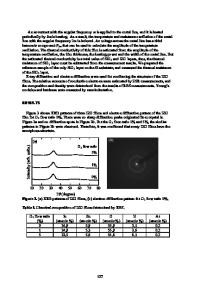Tailoring of Nanotextured Zinc Oxide Thin Films for Enhanced Biosensing
- PDF / 676,627 Bytes
- 6 Pages / 612 x 792 pts (letter) Page_size
- 40 Downloads / 460 Views
Tailoring of Nanotextured Zinc Oxide Thin Films for Enhanced Biosensing Michael Jacobs1, Rujuta Munje1, Bilal Quadri1, Sriram Muthukumar2, Shalini Prasad1 1
Department of Bioengineering, University of Texas at Dallas, 800 W. Campbell Road, EC 39, Richardson, TX 75080, U.S.A. 2
Department of Materials Science and Engineering, University of Texas at Dallas, 800 W. Campbell Road, EC 39, Richardson, TX 75080, U.S.A. ABSTRACT This study demonstrates the development of a zinc oxide (ZnO) based microelectrode sensor for the ultra-sensitive detection of protein biomarkers. Our research focuses on utilizing a materials-based approach to achieve this objective by utilizing ZnO as part of our biosensor for (1) improved surface binding to enhance sensitivity and (2) creating a nanotextured surface for enhanced output signal response. Nanotextured ZnO thin films were integrated onto printed circuit boards using RF magnetron sputter deposition. Films sputtered with and without the presence of oxygen were examined for possible differences in biosensor efficacy. These fabrication conditions not only dictate the number of oxygen vacancies within the film but also regulate the amount of zinc and oxygen terminated ends occurring on the material surface. The correlation between the surface terminations of the nanotextured ZnO to its performance as a biosensor was evaluated using two cross-linker molecules, dithiobis succinimidyl propionate and (3-aminopropyl)triethoxysilane, that maintain different binding chemistries to ZnO. Qualitative and quantitative assessment of cross-linker binding was accomplished using fluorescent microscopy and fluorescent intensity measurements. Electrical impedance spectroscopy (EIS) was used as the transduction mechanism for detection of the well-established cardiac biomarker, troponin-T. Utilizing EIS with a functionalized immunoassay on the ZnO surface, troponin-T was detected as low as 10 fg/mL using ZnO films sputtered without oxygen. This enhanced detection of the cardiac biomarker can be directly attributed to 1) oxygen vacancies within the metal oxide film, 2) the nanotexturing of the sensing site surface, and 3) the ability to bind a significant amount of cross-linker molecules for immobilizing capture antibodies. INTRODUCTION Biomarkers are unique biological macromolecules that may indicate the presence or risk of certain developing ailments. Point-of-care, rapid quantification of these molecules is essential to disease identification, monitoring, and analysis. Currently employed technologies for quantitative detection of protein biomarkers suffer from problems such as a lack of sensitivity/selectivity, dominance of signal noise, adaptability of detection to a wide range of biomolecules, and are not geared for rapid detection [1-3]. We chose to incorporate ZnO as a biosensing material due to its many desirable characteristics. ZnO has been previously used as a gas sensor, employing various transduction mechanisms such as electrochemical, optical, and even piezoelectric strategies [4, 5]. This is
Data Loading...











